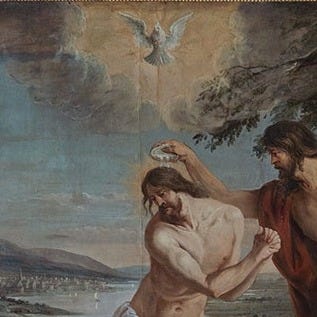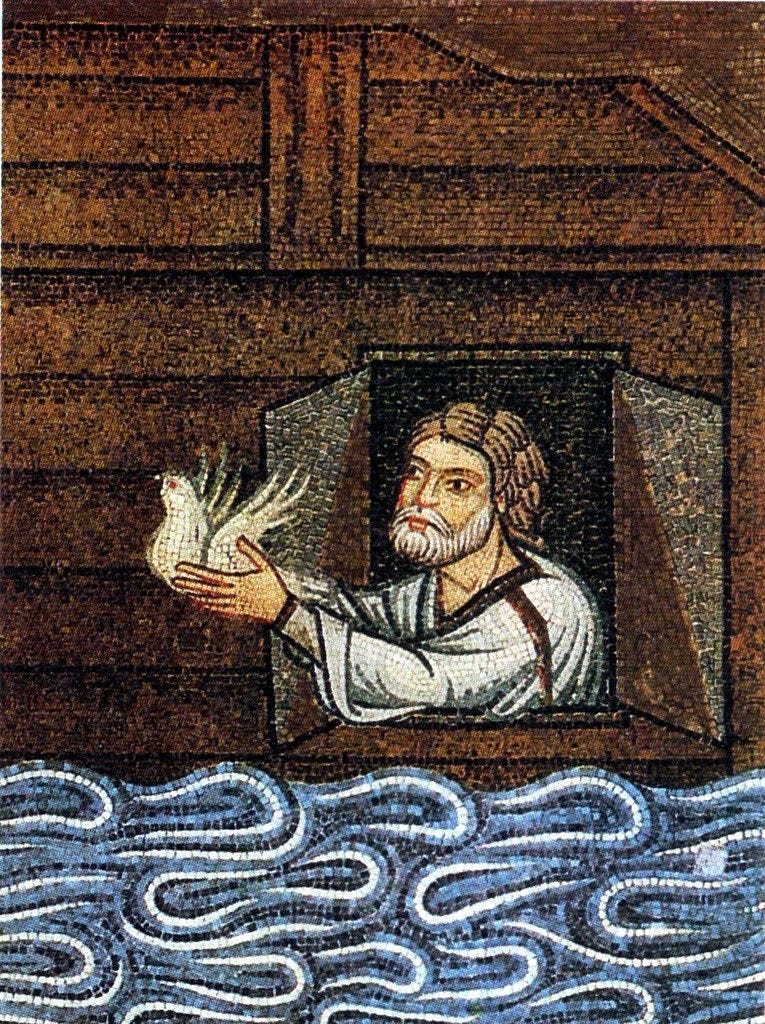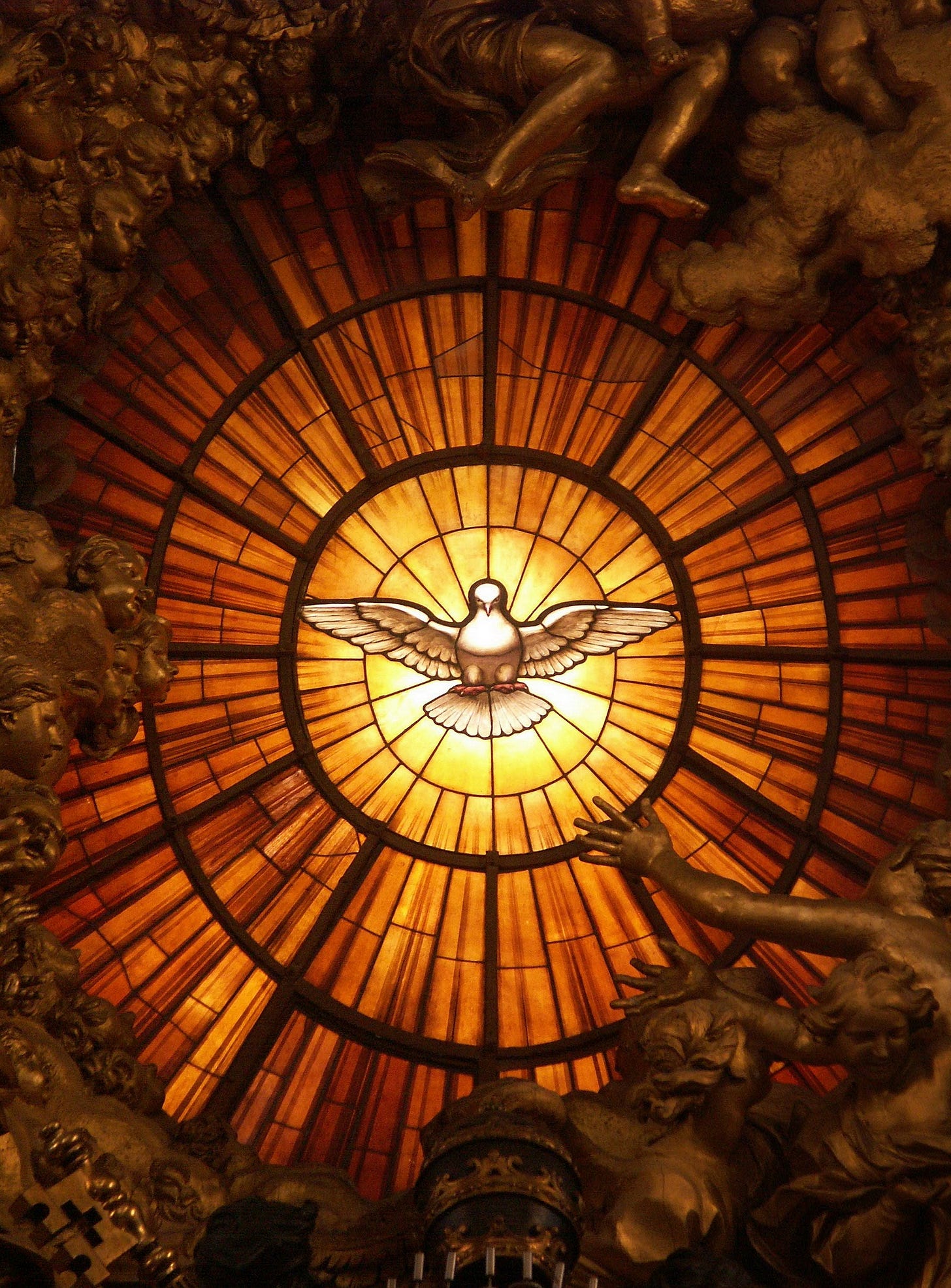
To those who, stirred by John’s preaching, had sought his baptism for repentance, the dramatic theophany of God after the baptism of Jesus would likely have been a startling experience. Already stirred by the grace of God, they witnessed the opening of the heavens, a voice from heaven, and the Spirit of God descending upon this man, possibly a stranger, in the form of a dove. Familiar with the history of their fathers, they would probably have recognized in the voice the thunder of God at Sinai, and in the “beloved son” a figure of Isaac, of Joseph, as well as the consecration of the firstborn because of the Exodus.
But how would they have understood the sight of a dove descending in the midst of these signs and wonders? How was God using this to teach them at that moment? God’s choice to manifest his Spirit in the form of a dove is a direct allusion to Noah and his covenant which thereby proclaims the real and present renewal of creation.
God’s choice to manifest his Spirit in the form of a dove is a direct allusion to Noah and his covenant which thereby proclaims the real and present renewal of creation.
It is difficult to make sense of the figure of the dove without connecting it to the dove in the story of Noah. That there is a deeper meaning involved here is indicated by the fact that all four gospels record that the Spirit descended as a dove (Mt.3:16, Mk.1:10, Lk.3:22, Jn.1:32). Certainly a dove is something of an unusual representation of the Spirit, who to that point had been adumbrated in the form of breath or wind (e.g. Gen.1:1), a rushing upon (e.g. Jdg.14:6, 1Sam.16:13), and will later be manifested at Pentecost by both these images as well as by fire (Acts 2:2-3).
Besides, there is a poverty of references to doves in the Old Testament, which generally restricts itself to metaphorical allusions to their attributes or general habits (e.g. Song of Songs 4:1). The only place to look for the significance of a dove’s actions is in the story of Noah.

If this seems a simplistic connection to make, so much the more likely is it that God would have chosen a clear and obvious way to reveal himself a people who, although likely illiterate, were familiar with the foundational texts of their covenant and Law.
Furthermore, it would not have been difficult for the witnesses of Jesus’ baptism to connect Noah’s dove to the mysterious action of the Spirit of God at the beginning of creation (Cf. Gen.1:1). To the attentive imagination, the text of Genesis paints a vivid picture of the events it narrates. The chaos of the flood that covered the earth, including the mountains, likely would have reminded its hearers of the primordial waters of Genesis 1. Additionally, the journey of the dove when she fails to find any land on the first time Noah sends her out (Cf. Gen.8:9) can easily be imagined in a similar way to the hovering of God’s Spirit at the very beginning.
Prompted by this connection in the imagination, the faithful listener would be able to recognize a deeper connection between creation and the flood. God’s wrath is not merely cleansing the earth of sin, but also re-establishing the original goodness of creation in true harmony and justice. The Spirit of God hovered over the primordial waters, and creation emerged; the dove of Noah fluttered over the flood waters and a new creation emerged: renewed and purified by the justice of God.
Seeing the dove of God descending on Jesus as he comes up out of the waters, those attentive to the Genesis symbolism of the dove would recognize in him a definitive “new creation,” fulfilling the intent of God from the beginning and in the covenant with Noah. When the dove returned from its second mission with an olive leaf, Noah knew that the waters—and therefore the anger of God at man’s sin—had abated (Cf. Gen.8:11).
The descent of the Spirit as a dove upon Jesus thus indicates that in him God’s wrath is fully satisfied. When the dove failed to return from its third mission, Noah knew the earth, freshly washed, was ready for its repopulation—for its “new creation.” Christ arises from John’s washing in the flesh as the new and definitive creation of God, ready to set about establishing his Kingdom through preaching the gospel and washing the people of all nations (Cf. Mt.28:19).
In the covenant with Noah, God promises never again to let the sins of man prompt another flood. The sign of this covenant is God’s bow—a weapon of punishment—hung up for all to see that God will not take it up again to punish the sins of man. Interestingly, this covenant does not promise that the sins of men will never again arise to the point of deserving another flood. But in his passion, Jesus receives the punishment for sin that satisfies God’s justice fully and thereby makes another flood unnecessary.
By his New Covenant, therefore, Christ establishes not merely the Noahtic absence of conflict between man and God, but also the presence of peace in the righteousness of a new creation.
Although there is certainly more to the symbolism of a dove than discussed here, the dove at the Baptism in the Jordan clearly points to the dove of Noah. The role of that dove also points to the mysterious Spirit of God through whom God created the world and drew it up out of the waters. Recognizing this Old Testament symbolism, the witnesses to Jesus’s baptism would rejoice in the mercy of God and seek to dwell in the justice of this “new creation.”
Seeing the Spirit of God descend upon Christ in the form of a dove, witnesses could be prepared to imagine that, symbolically, the dove that flew away from Noah seeking for a place to dwell in peace with her creator and vanished into mists of creation, after perhaps the largest ellipsis in salvation history, finally set her foot on the newly washed creation that is the Son of Man.




